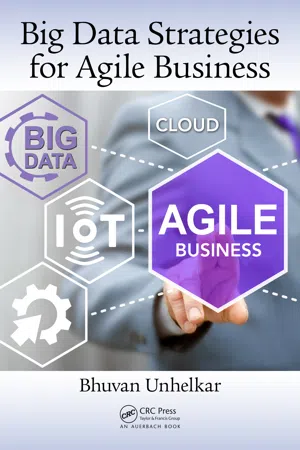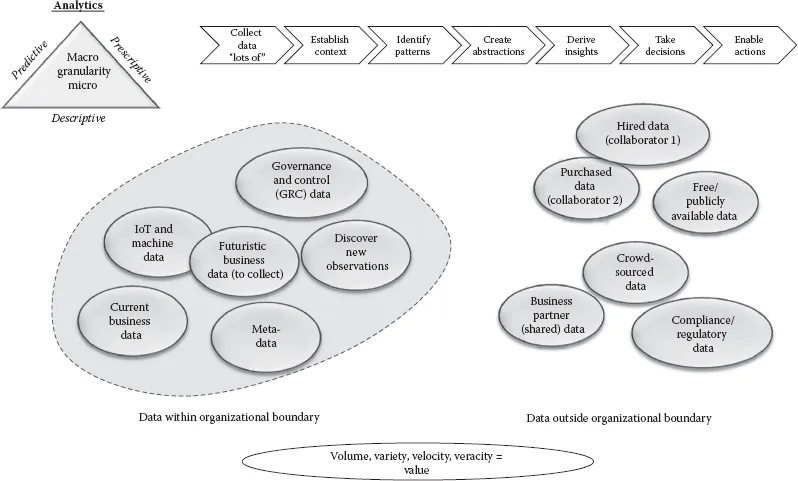
eBook - ePub
Big Data Strategies for Agile Business
Bhuvan Unhelkar
This is a test
- 503 pages
- English
- ePUB (adapté aux mobiles)
- Disponible sur iOS et Android
eBook - ePub
Big Data Strategies for Agile Business
Bhuvan Unhelkar
Détails du livre
Aperçu du livre
Table des matières
Citations
À propos de ce livre
Agile is a set of values, principles, techniques, and frameworks for the adaptable, incremental, and efficient delivery of work. Big Data is a rapidly growing field that encompasses crucial aspects of data such as its volume, velocity, variety, and veracity. This book outlines a strategic approach to Big Data that will render a business Agile. It discusses the important competencies required to streamline and focus on the analytics and presents a roadmap for implementing such analytics in business.
Foire aux questions
Comment puis-je résilier mon abonnement ?
Il vous suffit de vous rendre dans la section compte dans paramètres et de cliquer sur « Résilier l’abonnement ». C’est aussi simple que cela ! Une fois que vous aurez résilié votre abonnement, il restera actif pour le reste de la période pour laquelle vous avez payé. Découvrez-en plus ici.
Puis-je / comment puis-je télécharger des livres ?
Pour le moment, tous nos livres en format ePub adaptés aux mobiles peuvent être téléchargés via l’application. La plupart de nos PDF sont également disponibles en téléchargement et les autres seront téléchargeables très prochainement. Découvrez-en plus ici.
Quelle est la différence entre les formules tarifaires ?
Les deux abonnements vous donnent un accès complet à la bibliothèque et à toutes les fonctionnalités de Perlego. Les seules différences sont les tarifs ainsi que la période d’abonnement : avec l’abonnement annuel, vous économiserez environ 30 % par rapport à 12 mois d’abonnement mensuel.
Qu’est-ce que Perlego ?
Nous sommes un service d’abonnement à des ouvrages universitaires en ligne, où vous pouvez accéder à toute une bibliothèque pour un prix inférieur à celui d’un seul livre par mois. Avec plus d’un million de livres sur plus de 1 000 sujets, nous avons ce qu’il vous faut ! Découvrez-en plus ici.
Prenez-vous en charge la synthèse vocale ?
Recherchez le symbole Écouter sur votre prochain livre pour voir si vous pouvez l’écouter. L’outil Écouter lit le texte à haute voix pour vous, en surlignant le passage qui est en cours de lecture. Vous pouvez le mettre sur pause, l’accélérer ou le ralentir. Découvrez-en plus ici.
Est-ce que Big Data Strategies for Agile Business est un PDF/ePUB en ligne ?
Oui, vous pouvez accéder à Big Data Strategies for Agile Business par Bhuvan Unhelkar en format PDF et/ou ePUB ainsi qu’à d’autres livres populaires dans Business et Gestione dell'informazione. Nous disposons de plus d’un million d’ouvrages à découvrir dans notre catalogue.
Informations
Chapter 3
Data Science—Analytics, Context, and Strategies
Chapter Objectives






This chapter is mainly based on the second module of the Big Data Framework for Agile Business (BDFAB): data science—analytics, context, and technology. Specifically, as shown in Figure 2.1, this module draws attention to data, its various types and categories, and their utilization in analytics. Setting the context of a data point and the role of hex elementization in doing so is also discussed in this chapter. Furthermore, this chapter explains the crucial importance of granularity in data and analytics, and the setting of the OGL. Data science is presented as a discipline responsible for adopting and using Big Data in an iterative and incremental manner.
Data Science: Analytics, Context, and Strategies
Understanding the Importance of Data Science
Data science is a broad-ranging term that represents the technologies and analytics of Big Data. Additionally, though, data science can be understood as a discipline of utilizing technologies and analytics to convert data into actionable knowledge. Data science includes data mining, analytics (statistics), process modeling, machine learning (ML), parallel processing, and associated aspects of data management. The application of analytics to this data is the main step in arriving at insights. Therefore, data analytics remains at the core of data science. Data science, however, is closer to the business leadership and strategic decision making than data analytics. The evolution of data to actionable knowledge requires a specialist discipline that includes the study of data, its characteristics, its context in analytics, and eventually its value in business agility. These aforementioned activities require a wide coverage of various other disciplines within the organization and collaboration with many cross-functional teams. Therefore, the work of data science is interdisciplinary.
While analysis of data can focus on using the statistical expertise and management of data on the technical aspects, data science focuses on the strategic aspect of producing business value from data. This strategic aspect of data science requires domain knowledge of the industry where it is applied. For example, domain knowledge of the banking, finance, insurance, telecom, medical, and education industries is important in developing corresponding data strategies. Consider the following examples where data science provides value by combining the science of data with the domain knowledge:








Data science thus has wide-ranging applications in business decision making. Many internal organizational disciplines and functions provide input into data science. These are the disciplines of business strategies, project management, enterprise architecture, process modeling, solutions development, and quality assurance and testing. These disciplines complement those of data science. Figure 3.1 shows the effort involved in categorizing data, finding the correlation, undertaking analytics, and presenting the insights in an easy-to-use way for the end user.

Figure 3.1Data analytics, data categories (pools), and a subprocess for data transformation.
Data science considers the following in order to provide business value:




Table des matières
- Cover
- Half-Title
- Title
- Copyright
- Dedication
- Series
- Contents
- List of Figures
- List of Tables
- Foreword
- Preface
- Acknowledgements
- About the Author
- Domain Terms and Acronyms
- SECTION I INTRODUCTION TO BIG DATA STRATEGIES AND OUTLINE OF BIG DATA FRAMEWORK FOR AGILE BUSINESS (BDFAB)
- SECTION II ANALYTICS, PROCESSES, TECHNOLOGIES, ARCHITE CTURE, AND DATABASES WIT HIN THE BDFAB
- SECTION III QUALITY, GRC, PEOPLE AND THEIR UPSKILLING, AND AGILE BUSINESS WIT HIN THE BDFAB
- SECTION IV CASE STUDIES IN BANKING, HEALTH, AND EDUCATION
Normes de citation pour Big Data Strategies for Agile Business
APA 6 Citation
Unhelkar, B. (2017). Big Data Strategies for Agile Business (1st ed.). CRC Press. Retrieved from https://www.perlego.com/book/1515920/big-data-strategies-for-agile-business-pdf (Original work published 2017)
Chicago Citation
Unhelkar, Bhuvan. (2017) 2017. Big Data Strategies for Agile Business. 1st ed. CRC Press. https://www.perlego.com/book/1515920/big-data-strategies-for-agile-business-pdf.
Harvard Citation
Unhelkar, B. (2017) Big Data Strategies for Agile Business. 1st edn. CRC Press. Available at: https://www.perlego.com/book/1515920/big-data-strategies-for-agile-business-pdf (Accessed: 14 October 2022).
MLA 7 Citation
Unhelkar, Bhuvan. Big Data Strategies for Agile Business. 1st ed. CRC Press, 2017. Web. 14 Oct. 2022.